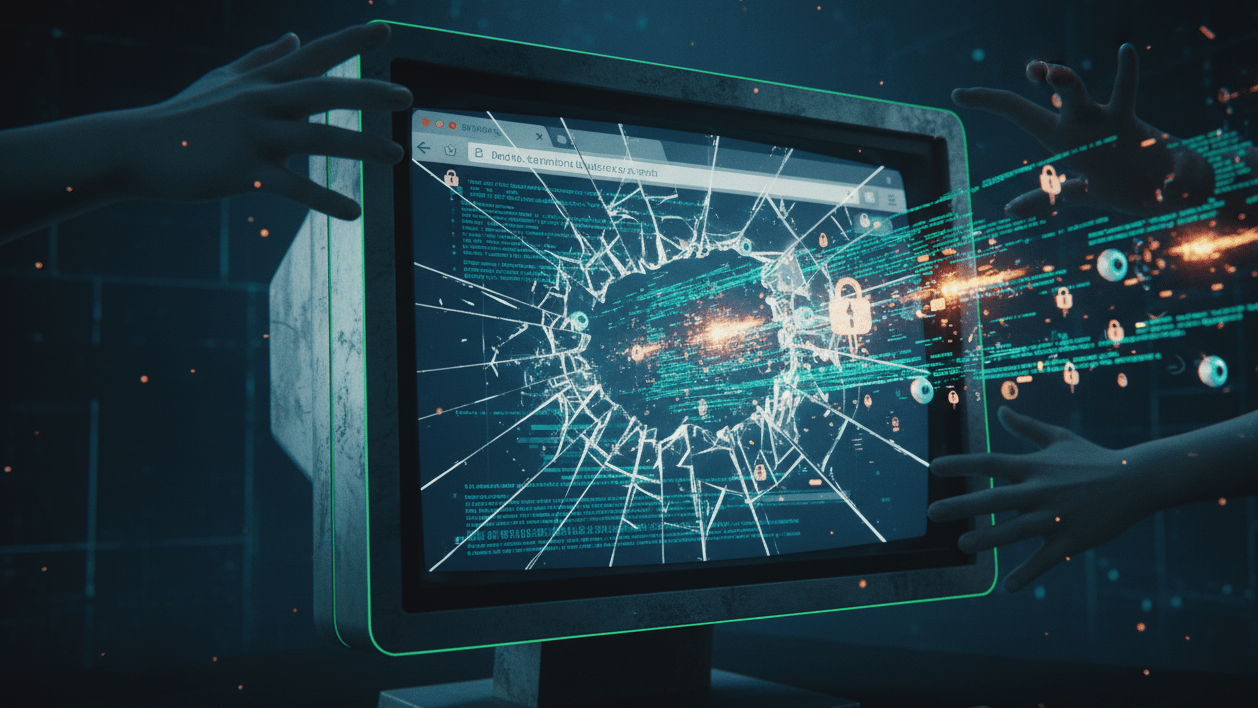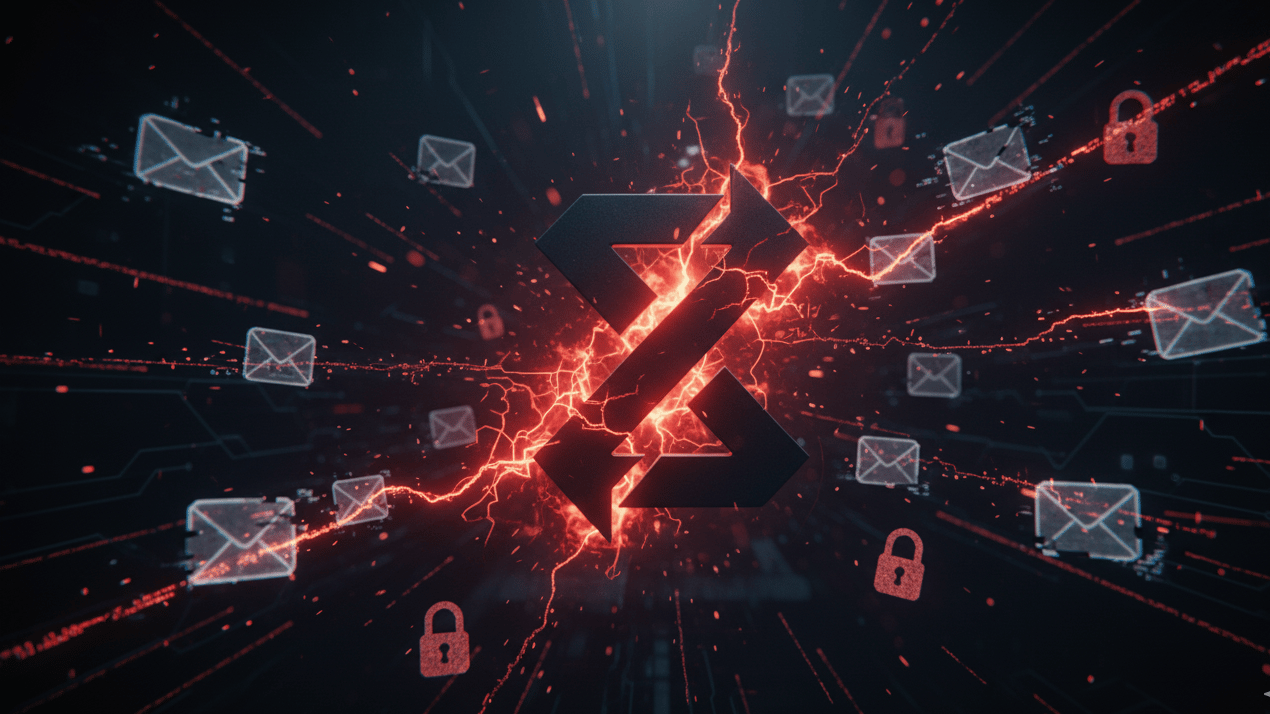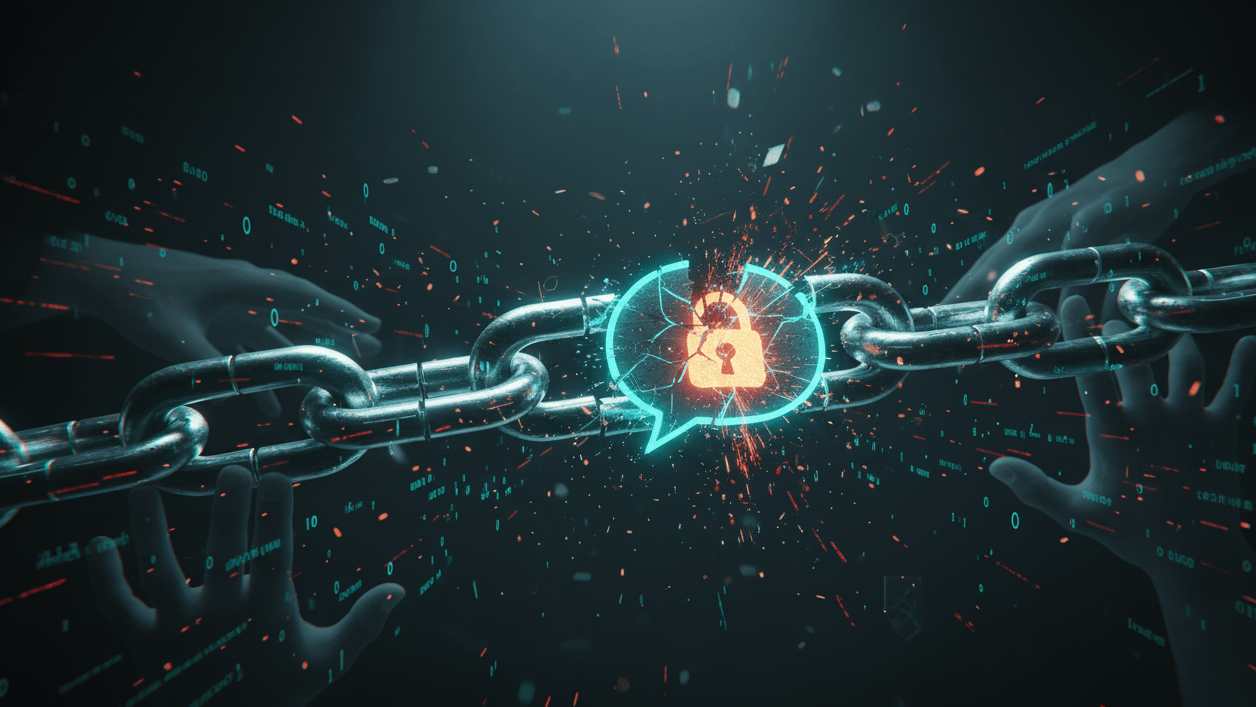- CYBERDEFENSE.NET
- Posts
- CYBERSECURITY ADRIFT : ARE YOU READY FOR THE ERA OF ROGUE AGENTS ?
CYBERSECURITY ADRIFT : ARE YOU READY FOR THE ERA OF ROGUE AGENTS ?
RED ALERT.

🤖 Dear internet users and fellow Cyberdefenders,
The signal flashed at 03:42.
A simple API key forgotten on GitHub.
Behind it, 400 billion dollars in digital assets open to the enemy.
While you were sleeping, the first enemy units breached your firewalls.
They are neither human nor slow.
They are autonomous AI agents. Invisible, fast, lethal.
They move via your browser, they copy your files into prompts, they infiltrate your Chrome extensions like spores in the air.
And the most tragic part ?
You invited them in yourselves.
Your teams? They're using ChatGPT without a pro account.
Your Exchange servers ? Exposed like roofless bunkers.
Your messaging systems ? Unprotected, non-sovereign.
A true tactical sieve. Central command (CISA, NSA, ENISA) is alerting : the battlefield has changed. The enemy no longer comes through the door... it's already inside, camouflaged in a browser session or a forgotten token.
But there is a resistance.
SOCs are strengthening, defensive AIs, innovative startups like Arsen or Bricklayer AI.
You too can join the front.
So, soldier, only one question remains: are you ready to fight ?
Read this newsletter, arm yourself with knowledge, and above all...
Never paste a database into an open prompt again.
Highlights :
👉 65% of AI unicorns exposed on GitHub: the $400 billion flaw 💥
👉 The browser, cybersecurity's new sieve: what nobody controls 🧠
👉 Microsoft Exchange: critical threat confirmed, your emails in the crosshairs 📉
👉 Accelerated cyberwar: when hackers become autonomous agents 🤖
👉 Corporate messaging: the weak link of a shattered cybersecurity ✉️

If this letter was forwarded to you, subscribe by clicking this link
🗞️ Guess what ?
65% of the most valued AI companies have published critical API keys and tokens on GitHub, often without their knowledge. These leaks compromise access to private models, sensitive datasets, or entire production environments.
The browser is now the main exit point for sensitive data, particularly via uncontrolled extensions and personal GenAI accounts. The majority of corporate data movements to the outside now occur through a simple copy-paste into a prompt field.
Microsoft Exchange 2016/2019 is no longer patched but continues to be used in many companies. This directly exposes messaging systems to targeted attacks, with no possibility of correction or simple mitigation.
Groups like Scattered Spider use autonomous AIs to map, infiltrate, and deploy ransomware in less than 24 hours. These automated agents make human detection almost useless without an equivalent AI response on the defense side.
Corporate messaging systems, always on the front line, often remain protected by basic, non-integrated solutions. Yet, this is still where the majority of compromises begin, in a context of increasingly fragile digital sovereignty.
🤓 Would you like to know more ?
1️⃣ 65% of AI unicorns exposed on GitHub: the $400 billion flaw
Summary : A Wiz study reveals that 65% of the AI 50 companies have leaked verified secrets – API keys, tokens, credentials – on GitHub, despite sometimes having non-existent or limited repositories. This paradox highlights a systemic security deficiency in a hyper-growth sector. These leaks can provide direct access to private models, sensitive training data, or strategic cloud resources, jeopardizing not only the companies concerned but also the entire AI ecosystem

Details :
Invisible but systemic leaks: API keys were found in deleted forks or commit histories, evading classic scanners. This reveals a deep flaw in the DevSecOps practices of AI startups.
Human flaws in notebooks: Many secrets were embedded in uncleaned .ipynb files or automation scripts. A lack of training coupled with product urgency leads to unaudited code.
Secrets = access to proprietary models: Some tokens gave access to private models or critical datasets. This amounts to a direct exposure of strategic intellectual property.
Insufficient response mechanisms: Half of the companies did not react to disclosures, lacking vulnerability disclosure processes. This organizational void accentuates the sector's vulnerability.
Wiz calls for native scanning: The systematic integration of secret scanners into CI/CD pipelines is becoming urgent. Without it, every Git push becomes a potential massive leak risk
What should be remembered ?
This situation confirms that the speed of innovation in AI is outpacing the cyber maturity of the players involved. A token leak, in this context, can lead to intellectual property theft on a very large scale. Governance must impose security from the code level.
2️⃣ The browser, cybersecurity's new sieve: what nobody controls
Summary : The Browser Security Report 2025 reveals a radical shift : the browser is now the main attack surface in the enterprise. Unverified extensions, SSO bypass, copying sensitive data into GenAI prompts via personal accounts – all behaviors invisible to traditional cybersecurity tools. The study shows that 68% of SaaS connections occur outside of SSO, and 77% of users paste data into AI without supervision.

Details :
The browser has become the critical endpoint: It concentrates GenAI, SaaS, messaging, extensions – but remains off the radar of DLP, EDR, or SSE. It's a gray area that attackers are already exploiting.
AI is the new leak channel: 77% of employees copy data into GenAI prompts, often from personal accounts. A silent, invisible, and uncontrolled exfiltration.
Extensions: the modern Trojan horse: Over 50% of installed extensions have critical permissions, without publisher verification. They can inject code, siphon cookies, or hijack sessions.
AI browsers blur the lines: Tools like Arc Search or Perplexity read and summarize pages, but also remember active sessions. This introduces a permanent risk of passive interception.
Security must be anchored in the browser: Native solutions like Talon or LayerX offer session-level visibility. It's the only way to control what is really happening at the user interface.
What should be remembered?
The modern workstation is no longer located on the network, but in the browser. Without visibility at this level, any DLP or SSE strategy is incomplete and blind.
3️⃣ Microsoft Exchange : critical threat confirmed, your emails in the crosshairs
Summary : With the end of support for Exchange Server 2016 and 2019, millions of servers are becoming vulnerable targets. CISA and the NSA warn: these servers are under "imminent threat." Best practices recommend an urgent migration to cloud solutions or Exchange SE, but many companies, especially in critical sectors, persist in exposing their infrastructures to the Internet, amplifying the risks of compromise by ransomware or BEC.

Details:
End of support = structural flaw: Exchange 2016 and 2019 no longer receive security patches. EOL servers expose companies to active vulnerabilities, like CVE-2025-53786.
Servers still exposed to the Internet: Despite CISA/NSA alerts, many servers remain accessible from the web. This multiplies the attack vectors for APT groups.
Multiple impacts: fraud, interruption, compromise: Exchange is a prime target for BEC, ransomware, and stealth intrusions. The impacts range from data theft to complete paralysis.
Complex patching, hesitant migrations: Patches require service interruptions that many admins postpone. This delays migrations to secure cloud solutions.
The call to the cloud becomes strategic: Coalition recommends the total abandonment of on-premise Exchange. Exchange Online or sovereign solutions are becoming the only rational choice in 2026.
What should be remembered ?
Exchange servers are becoming the weak link in email infrastructures. Persisting in their use is equivalent to maintaining an active flaw in one's nerve center.
4️⃣ Accelerated cyberwar : when hackers become autonomous agents
Summary : Agentic AI is shaking up cybersecurity : it allows cybercriminals to launch orchestrated attacks in under 24 hours, while also offering defenders ultra-performant SOC automation tools. At Black Hat 2024, experts warned of two threats: the offensive use of autonomous agents for phishing, recon, and ransomware; and the compromise of these same agents, which then become powerful internal relays.

Details:
AI agents accelerate attacks : Groups like Scattered Spider use agentic AI to launch ransomware attacks in under 24 hours. The execution speed surpasses human reaction capability.
Deepfake identities generated to infiltrate : AI profiles allowed North Korean groups to infiltrate 320 companies. Phishing is now reinforced by automated impersonation.
SOCs augmented by defensive AI : Security operations centers also use AI to sort alerts, correlate, and execute automated responses. This drastically reduces investigation times.
AI agents = strategic target for attackers : By compromising an agent, an attacker gains access to a trusted automated system. This is a silent and hard-to-detect escalation.
Towards an unstable cyber-equilibrium : Agentic AI creates a worrying symmetry between offense and defense. Only SOCs capable of automating effectively will survive this new era.
What should be remembered?
Cybersecurity is becoming a war of algorithms. Agentic AI, poorly used, can cause havoc... used well, it saves critical hours in SOCs.
5️⃣ Corporate messaging : the weak link of a shattered cybersecurity
Summary : D According to Benoît Trémolet (Retarus), messaging remains the primary entry point for cyberattacks, but companies still protect it with overly basic tools. The younger generations underestimate the risk and overestimate their detection capabilities. Furthermore, reliance on foreign suppliers weakens digital sovereignty. He advocates for an integrated, sovereign, and messaging-oriented approach

Details:
Email remains the #1 entry point: Phishing, social engineering, spear phishing: all attacks exploit human weakness via email. And protection solutions often remain rudimentary.
The younger generations, an unexpected weak link: 18–34 year-olds, despite being digital natives, underestimate cyber risk. They overestimate their ability to detect attacks.
Isolated tools in complex architectures: Most companies secure messaging without seeing its integration with CRMs, ERPs, and third-party tools. This creates fragmented, easily bypassable security.
Vague distribution of responsibility: Messaging security is no longer just the IT department's job. It must be shared with management, HR, communications – it's a cross-functional issue.
Digital sovereignty at stake: Entrusting one's messaging to American solutions multiplies legal, technical, and strategic risks. The preference for European actors is becoming an imperative.
What should be remembered?
Email is the keystone of cyberattacks. Not treating it as a critical and strategic asset amounts to ignoring the first exploitable flaw by the enemy.
⚙️ Digital Combat Ops
The Malwarebytes method to stop attacks invisible to classic antivirus
Malwarebytes is innovating in cybersecurity with an anti-ransomware technology capable of blocking attacks that the majority of security solutions do not detect. Unlike classic protections that assume ransomware operates locally, Malwarebytes accounts for remote encryption scenarios, via network shares or unprotected machines.
Its solution rests on two pillars: monitoring local processes attacking remote files and, conversely, detecting remote attacks targeting local files. Thanks to real-time behavioral monitoring, fine-tuned network detection, and an intelligent scoring system, the software blocks only malicious connections without disrupting other activities.
The architecture, optimized for performance, allows for a rapid reaction without false positives. This proactive approach doesn't just target known ransomware but also anticipates future variants through dynamic behavioral analysis. Malwarebytes thus fills a critical gap ignored by the majority of competing solutions.
LIEUTENANT'S REPORT 🏆
The war for minds begins : Arsen trains your troops against social engineering
Arsen Security is a French startup based in Paris, specializing in human cybersecurity. It develops realistic simulation platforms (phishing, smishing, vishing) based on AI, to train employees to detect and counter social attacks. The tool allows for fine-tuning scenarios based on job role, observed behavior, and risk level.
Highlight :
Between 2023 and 2024, Arsen deployed its campaigns in several large French groups (banking, energy, public sector), with a measurable impact: a 47% decrease in clicks on simulated phishing in 3 months. Thanks to AI, the tool automatically adapts scenarios to each employee (language, pace, context) and offers personalized remediation. This "cognitive cybersecurity" approach marks a turning point: we are no longer just protecting systems, but human reflexes. This is a concrete response to the issue raised earlier in this newsletter – notably the lack of cyber awareness among the younger generations.
CYBERTRIVIA - DID YOU KNOW ? 🤔
In 2024, over 40% of ransomware attacks used network shares to encrypt files remotely... without ever executing code on the target machine. These attacks completely evade classic antivirus, as the malicious process is on another device. A company can therefore see its files encrypted... without ever detecting the threat. This is exactly the type of attack Malwarebytes aims to block with its dual-layer anti-ransomware architecture.
Do you think your company could detect a ransomware attack launched from a remote station on the network? |
👉️ Let me know if you need further adjustments !
Don't miss any crucial cybersecurity news! Subscribe now to our newsletter to receive in-depth analysis, expert advice, and stay informed about the latest threats and solutions to protect your business. 'This is for all the newcomers: I have only one rule. Everyone fights. No one quits.
